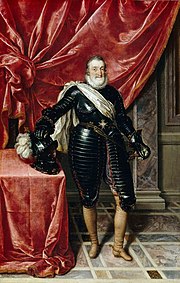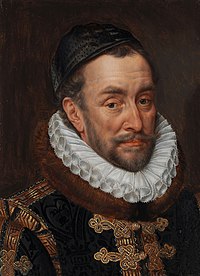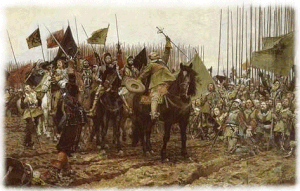European History/Religious Wars in Europe
During the period of 1524 until 1648, Europe was plagued by wars of religion. It is important to recognize, however, that while religion was given as the reason for war, there were many other reasons as well. These included land, money and economics, political power, natural resources, and more.
These wars included the Peasants' War of 1525 in the Holy Roman Empire, the Schmalkaldic War of the 1540s through 1555, an ongoing fight between the Holy Roman Empire and the Turks, the Hussite rebellion, and missionaries and conquistadors versus Native Americans.
Warfare
[edit | edit source]Religious fighting and warfare spread with Protestantism. The radical new doctrine in Germany brought other simmering social tensions to a boil; peasant revolts flared in 1525, resulting in chaos and bloodshed across Austria, Switzerland and southern Germany. Wealthy landowners were the target of downtrodden rebels demanding social equality and sharing of wealth in common. Armies loyal to ruling princes suppressed the revolt, and the leaders were executed. Martin Luther, chief initiator of the Reformation, turned against the rebels and defended the authorities' moves to put them down.
Peace of Augsburg
[edit | edit source]
The Peace of Augsburg in 1555 declared the Prince's religion to be the official religion of a region or country (cuius regio, eius religio). This resulted in the acceptance of toleration of Lutheranism in Germany by Catholics. When a new ruler of a different religion took power, large groups had to convert religions. Most people found this to be realistic, and the process did not end until 1648.
In northern Europe (north Germany, Netherlands, and France), the middle class tended to be Protestant, which corresponded with their work ethic and philosophy. Peasants readily converted religions in order to obtain jobs.
Treaty of Cateau-Cambrésis
[edit | edit source]With the Treaty of Cateau-Cambrésis in 1559, Spain and France agreed to stop fighting with each other in order to unite against their common Protestant threat, particularly Calvinism, which was considered more of a threat than Lutheranism.
French War of Religion
[edit | edit source]In France, religious civil war took place from 1562 to 1598 between Catholics and Protestants. The crown usually supported the Catholics but occasionally shifted sides, while the nobility was divided among the two camps. The three leading families in the nation competed for control of France. These families were the Valois family, which was currently in power and was Catholic, the Bourbon family, which consisted of Huguenots (French Protestants), and the Guise family, who was also Catholic. Ultimately, the Bourbon family won the war, but its leader Henry of Navarre was unable to be crowned because the strongly Catholic city of Paris shut itself down. Henry put Paris under a year of siege before finally deciding to convert to Catholicism himself in 1593. The civil war in France was ended by the Edict of Nantes in 1598, which reaffirmed that Catholicism was the official religion in France, but also granted a significant degree of religious and political freedom to Protestants.
Henry IV could be described as a politique, or one who cares more about his nation's peace and prosperity than he does the enforcement of religious toleration.
Spanish Conflict with the Dutch
[edit | edit source]In 1566, on the Assumption of the Virgin day, a group of Calvinists in the Netherlands stormed Catholic churches, destroying statutes and relics in a town just outside of Antwerp. Dutch Calvinists resented the Catholic religion and their conflicts with the religion, as well as Spanish King Philip II's deep devoutness and close-mindedness toward other religions. The high nobility pleaded with him for more tolerance but some of them were put to death for their insolence. One of the underlying reasons was that Philip wanted to establish an absolute monarchy in the Netherlands and the religious issue gave him a way to put pressure on the parliament. William of Orange escaped to Germany from where he tried to incite a rebellion from 1568 onwards but with little success at first. In 1570 the coastal regions got hit by a weather-related disaster, the All Saints flood that left many regions devastated and the Spanish authorities showed little compassion. William of Orange, then encouraged Sea Beggars, or pirates, to invade the ports of the coast. In 1572 the small town of Brielle was taken by what were no more than outlaws, greeted enthusiastically by the population. The town declared itself for the prince of Orange and this example was followed by a number of other towns in the relatively inaccessible provinces of Holland and Zeeland.

Philip sent Spanish troops in response. They took Naarden and Haarlem and inflicted horrible suffering on the population. Other towns proved far harder to take and this caused Philip to run out of money. In what became known as the Spanish Fury, in November of 1576, Philip's unpaid mercenary armies attacked the city of Antwerp killing 7,000 in 11 days. Antwerp was by far the richest city at the time and the influential merchants got the parliament to convene and raise money to pay off the marauding mercenaries. By doing so the parliament basically took over control from the king in far Madrid and this was the last thing the king wanted. He sent more troops with an ultimatum to the parliament to surrender or else and appointed the Duke of Parma as the new governor of the Netherlands. In 1579, the southern ten provinces of the Netherlands, which were Catholic, signed the Union of Arras, expressing loyalty to Philip. During that same year, William of Orange united seven northern states in the Union of Utrecht, which formed the Dutch Republic that openly opposed Philip and Spain. In 1581, the Spanish army was sent to retake the United Provinces of the Netherlands, or the Dutch Republic, who had just declared their independence.
On July 10, 1584, William of Orange was assassinated, and after his death, the Duke of Parma made progress in his reconquest, capturing significant portions of the Dutch Republic. However, England, under the leadership of Elizabeth I, assisted the Dutch with troops and horses, and as a result Spain was never able to regain control of the north. Spain finally recognized Dutch independence in 1648.
The Spanish Armada
[edit | edit source]
Catholic Philip II of Spain desired to remove Elizabeth I of England from the throne after her rise to power following "Bloody" Mary Tudor's fall to illness. Philip was primarily angry over Elizabeth's actions against English Catholics, but he was also upset as a result of attacks by English privateers upon Spanish vessels, Elizabeth's assisting enemies of Spain such as the Netherlands, and the execution of Mary, Queen of Scots.
Philip devised a plan to invade England. The four components of this plan were to bring a large army into the Netherlands under the lead of the Duke of Parma and get them prepared to invade England. In addition, the Duke of Medina-Sardonia would prepare a large fleet with extra men, and equip the men to join up with the Duke of Parma's army. Then, Spain would use its fleet to win control of the English Channel and protect the Duke of Parma's invading force as it crossed. Finally, the troops would invade England and force Elizabeth to agree to Spain's demands: to allow English Catholics to worship in the way that they wanted, to stop assisting Protestant Dutch rebels in the Spanish Netherlands, and to pay reparations for the cost of the invasion as well as English damage to Spanish ships. Philip did not, however, have any intent to conquer England - he simply desired Elizabeth to cede to Spain's demands. Although on 29 July 1587, Pope Sixtus V had granted Papal authority to overthrow Elizabeth, who had been declared a heretic by Pope Pius V, and place whomever he chose on the throne of England.
Initial Problems with the Plan
[edit | edit source]There were a number of problems with Philip's plan. First, the Duke of Medina-Sardonia was appointed leader of the operation. He had no naval experience and was fatalistic. Moreover, the Duke of Parma refused to cooperate, as he wanted to be the commander. As a result, he did not assemble enough vessels. In addition, during the preparations, Sir Francis Drake of England raided the city of Cadiz and sank 30 Spanish vessels and burnt barrel staves, resulting in the food for the armada becoming spoiled. Finally, the invasion consisted of 131 ships, resulting in difficult communications.
The Attack
[edit | edit source]The Armada arrived in late July of 1588, and was spotted immediately by English lookouts. At this time, the Duke of Parma still needed a few more days to prepare the troops. On July 20, Admiral Howard of England devised a plan using fireships, or ships filled with combustibles, to attack the Spanish fleet. These attacks resulted in the Spanish fleet cutting its anchors. On July 29, the major confrontation took place, called the Battle of Gravelines. The Spanish tactics were outdated - they were to sail in close, fire one volley at the English ships, and then proceed to board the English vessels. However, the English navy had devised new tactics, using smaller, more maneuverable ships with longer range, movable cannons. But this new tactic was not decisive, because little damage was done to ships in formation. On the other hand all attempts to leave the formation led to immediate destruction by combined fire of the English ships. When the English fleet was able to scatter the Spanish formation with burners, the Armada decided to retreat. This, coupled with the so-called "Protestant Wind" that blew the Spanish ships through the English Channel, resulted in the Spanish defeat. On May 28, 1588, the Armada had set sail with 131 ships and 30,000 men. 67 ships and around 10,000 men returned. Many ships sank along the Irish coast, about 5000 men died from starvation and others were executed in Ireland by English authorities.
Results of the Spanish Armada
[edit | edit source]The Spanish fleet was able to recover from this defeat in numbers, but morale was shattered. The events marked the rise of English naval power. In addition, they resulted in Dutch independence since Spain could not defeat England. The events were thus a blow to the Counter-Reformation, leading to an overall decline in the Counter-Reformation's effects.
The Decline of Spain
[edit | edit source]It is a common misconception that the failure of the armada resulted in the decline of Spain.
After the failed invasion of England, Spain soon began to enter a period of decline. This occurred for a number of reasons. The Counter-Reformation had drained considerable Spanish resources. Moreover, many of the resources of the Spanish colonies had been exhausted. Additionally, only one-third of Spain's population actually worked - one-third of the population belonged to the clergy and another one-third belonged to lower nobility - and there was no middle class in Spain, and a small higher class. Finally, inbreeding caused inept leadership in the monarchy.
The Thirty Years' War
[edit | edit source]
The Thirty Years' War was sparked by the Defenestration of Prague, at which Protestants threw Catholic ambassadors out of a window in the city of Prague. The Thirty Years' War had started as a war along religious frontlines, but the role of religion greatly diminished later. The Catholic French funded the Protestant Dutch, Protestant Princes in the Holy Roman Empire, as well as other non-Catholic nations such as Sweden, Denmark, and the Ottoman Empire, since all of these nations were fighting the Habsburgs. France, led by Cardinal Richelieu, chief minister for Louis XIII, desired to reduce the power of Austria by funding Austria's enemies. The war was essentially a fight between the two powers to determine which would become the main power in Europe. Although a high member of the hierarchy of the Catholic Church, Richelieu can be described as a politique, as he put national interest ahead of his religion. Indeed, Richelieu openly funded Protestant groups in his fight against the Habsburgs.
Precursors to the War
[edit | edit source]The Schmalkaldic Wars and the Peace of Augsburg started in the 1540s and ended in 1555 created a number of issues for Charles V of Habsburg. The debate over what religion German states could adopt had not been resolved, as the Peace of Augsburg provided for the states' princes to adopt either Catholicism or Lutheranism, but not Calvinism. The issue of the German princes' power and sovereignty was also at bay, as the princes increasingly desired more power. Finally, the princes had been seizing Church land, angering Charles V.
Bohemian Phase (1618-1625)
[edit | edit source]Protestant Bohemians rebelled for religious freedom and independence from Habsburg rule. The Defenestration of Prague, in which rebels threw two of the Holy Roman Emperor's, Ferdinand II, Catholic officials from a castle window, initiated the war in 1618. After ruthless retaliation by Ferdinand, Bohemia was completely converted to Catholicism and defeated.
Danish Phase (1625-1630)
[edit | edit source]King Christian of Denmark supported north German Protestants. Catholic general Albert Wallenstein was hired to defeat Protestant forces and restore Catholic land lost. As a result of Austrian victories, Ferdinand II issues the Edict of Restitution in 1629, ordering that no longer could Protestants seize and secularize Catholic land. In the Siege of Madgeburg, Wallenstein's mercenary force, out of control, massacred the entire town of Madgeburg, including both Protestants and Catholics. Again, Austria is victorious, and Denmark is relatively easily defeated.
Swedish Phase (1630-1635)
[edit | edit source]Swedish King Gustavus Adolphus, devout Lutheran, came to Germany's aid. Austria ultimately defeated Sweden, and it looked like peace was likely. The Edict of Restitution was thus withdrawn.
French/International Phase (1635-1648)
[edit | edit source]Though a Catholic state, France had felt threatened by the strengthened Habsburg Empire, and joined the war in 1635 on the side of the Protestants, thus ending the strictly religious character of the war. A combined French/Swedish alliance triumphed over Habsburg forces, while the Dutch, also allied to France, finally won their formal independence from Spain. In 1648, with all sides exhausted, a final series of peace treaties were prepared.
Peace of Westphalia (1648)
[edit | edit source]
The Treaty of Westphalia ended the last major religious war in Europe. The settlement would serve as a model for resolving conflict among warring European nations, as it represented the first time a diplomatic congress addressed and resolved a dispute. This was the first time that all parties were brought together at once rather than two or three at a time.
Beneficiaries of the Treaty of Westphalia
[edit | edit source]- France, now the dominant power in Europe, surpassing Spain and Austria. France also got Alsace-Loraine and wins the Thirty Years' War, stopping German unity.
- Dutch and the House of Orange. Spain and the Holy Roman Empire finally recognized their independence, and for the next 60 years, were the leaders in trade, shipping, and a major economic powerhouse in Europe.
- Swiss. They earned independence from the Holy Roman Empire.
- Sweden. They now controlled the Baltic Sea and became the most powerful nation in the north.
- Prussia and the Hohenzollerns. This marked the start of Prussia's rise as a great military power.
- German princes. The princes now won sovereignty and could select Calvinism for their states.
- Protestants. The Peace of Westphalia marked the end of the Counter-Reformation and Calvinism was now tolerated.
Losers at Westphalia
[edit | edit source]- Spain and the Spanish Habsburgs. The Spanish lost colonies and territorial possessions, resulting in a loss in income.
- The Holy Roman Empire, Austria, and the Austrian Habsburg. 1648 marked the definite end of the Holy Roman emperor's power over the Holy Roman Empire, as the princes are now sovereign.
- Catholicism. The Peace of Westphalia marked the end of the enforced Counter-Reformation and thus the end of the church's supremacy and papal authority.
- German Unity. Germany was kept disunited and was divided into hundreds of individual, sovereign states governed by princes.
European History
01. Background •
02. Middle Ages •
03. Renaissance •
04. Exploration •
05. Reformation
06. Religious War •
07. Absolutism •
08. Enlightenment •
09. French Revolution •
10. Napoleon
11. Age of Revolutions •
12. Imperialism •
13. World War I •
14. 1918 to 1945 •
15. 1945 to Present
Glossary •
Outline •
Authors •
Bibliography
